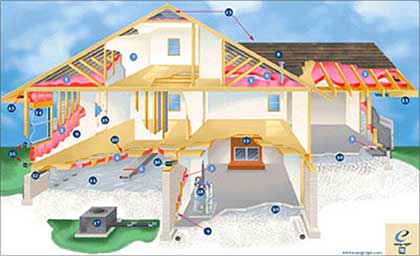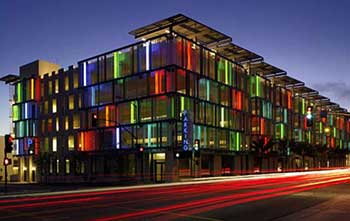The New House: A Model of Energy Efficiency

Image © Energy Right Partners There are many ways to make a new building energy efficient. Insulation can be added to exterior walls, ceilings and attics, basements, around heating and cooling ducts, and in framed floors. Covers and dampers on vents to the outside or unheated or cooled areas (such as exhaust fans and attic entries) also help save energy. Energy-efficient windows, doors and appliances add to the energy savings. |
Energy efficiency occurs in two ways. First, the house must be able to maintain a comfortable indoor temperature for the climate, using the least amount of energy possible. And a building that loses less energy is a building that uses less energy. Second, the appliances that run the house—the heating and cooling systems, lights, kitchen and other appliances—must be energy efficient. When both of these overall approaches are maximized, the house will use less fossil fuels and electricity, thus reducing CO2 emissions.
The simplest route to energy efficiency: start from scratch, by building a new house. A new house can easily incorporate some of the techniques from passive heating and cooling, along with building materials—old and new—and appliances that help minimize the use of electricity or fossil fuel. The construction of an energy-efficient home requires careful and detailed planning using what is called a “whole-house systems approach.” The approach looks at the interaction between the home, the environment, and the people who live there, to determine the best systems to use for heating and cooling, insulation, windows, lighting, appliances and electronics, water, and waste disposal.
Building Standards to Save Energy

Photo © John Edward Linden, photo courtesy Moore Ruble Yudell Architects & Planners The Santa Monica Civic Center Parking Structure, in Santa Monica, California, was built to LEED standards. It runs on solar power, uses fluorescent lighting and reclaimed water for landscaping and toilets, and is built partly from recycled materials.
|
|||||
|
Around the world, countries, states, and cities have developed voluntary “green” building standards. In the United States there is a certification program called LEED (Leadership in Energy and Environmental Design), which has been created by the nonprofit U.S. Green Building Council. It rates all aspects of design, construction, and operation, mostly for large-scale construction, such as government buildings, schools, and commercial spaces. The LEED system has been adopted in several countries, including India, Israel, and Canada. The Standards and Industrial Research Institute of Malaysia has recommended green building standards for that country.
In the United States, the city of Boulder, Colorado, has developed its own elaborate point system for energy-efficient building. Architectural designs will not be approved unless they earn a certain number of points, for such elements as insulation, precast concrete foundations, planting of shade trees, and energy-efficient windows. The Boulder program also requires that houses be disassembled rather than torn down and that at least 65% of those materials be recycled.
There are also programs to label appliances and products that are energy efficient. In the United States, the Environmental Protection Agency created the “Energy Star” program in 1992 for this purpose. More recently, the agency has designated Energy Star buildings as well. There are other nonprofit agencies that promote different aspects of energy efficiency around the world. One example is the Alliance to Save Energy, which is based in the United States but supports programs to increase energy efficiency around the world, in places such as China and Eastern Europe.
By using the different construction standards available and looking for energy-efficient appliances to use in the house, the builder/owner has the necessary guidelines for how to build a house that uses less energy inside.
Let's take a closer look at how to build an energy-efficient house. What type of walls, roofing, and insulation do the best job of reducing energy use?
This content has been re-published with permission from SEED. Copyright © 2025 Schlumberger Excellence in Education Development (SEED), Inc.


